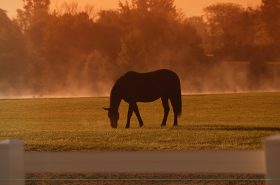There are many factors to consider when installing footing for your riding arena.
Horse health and soundness can be greatly affected by the surface that the horse trains on. Quality arena footing provides the horse with stability and most important confidence. It minimizes the concussion of the footfall, absorbs shock, provides support, and provides energy back to the horse. The correct footing has the right amount of firmness, cushioning, rebound, and grip.
Base
The base provides a solid foundation for your arena footing. I was once told the base is almost more important than the footing itself because without the right base the footing won’t perform at its optimum. When installing your base drainage needs to be considered. The fall or crown of the base needs to be professionally done in order to provide the correct run-off for drainage. There are base options that are more economical and there are options that are a larger investment but guarantee arena use in all weather conditions.
Sand
Choose the right sand! It is incredibly important that you choose the right sand for your arena footing. There are thousands of types of sand in the U.S. and different types occur in different areas of the country. Not all sands are appropriate for riding arenas.
Textile and Fiber
Textiles and fibers are added to the sand. The textiles retain water thereby binding with the sand particles to provide cushion and stability. Rubber is another material that can be added to horse footing. It provides cushion and drainage to sands that may compact more than others.
Hydration
Watering footing is essential unless you install a waterless and dust-free footing. Dust can be very harmful to both human and horse. Footing that is too dry does not allow the textile and sand to bind properly resulting in a shifty, unstable surface. Waterless footing is a bigger investment. Other footing options are less expensive but take a bit more time to maintain.
Grooming Equipment
Grooming your footing regularly to remove hoof divots and to mix the sand and fiber is necessary. The correct equipment you use to groom your footing is important. You want to choose a groomer with tines that will mix the sand and textiles. You also want to choose something that will compact the footing as well.
These are the basics to consider when you’re deciding what arena footing to purchase. It’s best to research different footing companies and talk to a footing expert to help you decide what is best for you and your horse.



